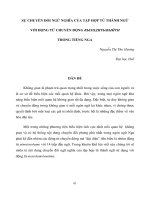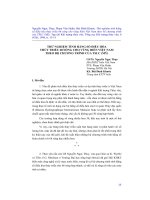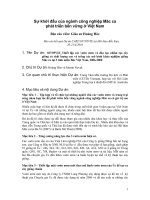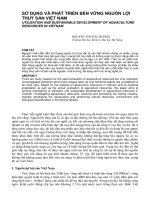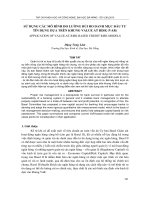Báo cáo nghiên cứu khoa học: "Sự tham gia của khu vực tư nhân trong phòng chống HIV / AIDS tại Việt Nam - Một mô hình hợp tác công-tư nhân (PPP): tăng cường tiếp cận với các dịch vụ sti nhất ở các mức rủi ro (MARPS)" ppt
Bạn đang xem bản rút gọn của tài liệu. Xem và tải ngay bản đầy đủ của tài liệu tại đây (178.55 KB, 12 trang )
275
JOURNAL OF SCIENCE, Hue University, N
0
61, 2010
INVOLVEMENT OF PRIVATE SECTOR IN HIV/AIDS PREVENTION IN
VIETNAM – A PUBLIC-PRIVATE PARTNERSHIP (PPP) MODEL: INCREASE
ACCESS TO STI SERVICES OF THE MOST AT RISK POPULATION
(MARPS)
Pham Duc Minh, Nguyen Chien Thang, Ton van der Velden, Le Ngoc Bao
Pathfinder International Viet Nam
Mai Hoang Anh
Prevention of AIDS and TB Centre
SUMMARY
Introduction: Having sexual transmitted infection (STI) increases the risk of HIV
infection. The MARPs identified as female sex workers (FSWs) and intravenous drug users
(IDUs) have limited access to STI services; lack of knowledge and awareness on need for
STI/HIV related services, financial difficulties, and more importantly fear of stigma or even
legal sanction are main barriers. Literature sugested that MARPs preferred STI services
provided at private sector in order to secure privacy and confidentiality. Methodology: The
intervention project developed and piloted a voucher scheme for the MARPs to use STI services
at 9 assigned private clinics in 4 districts of An Giang province. The Provincial Center for AIDS
and TB Control (PATC), through peer educator network, provided vouchers for MARPs for free
STI (examination and treatment) and HIV counseling services. District health centers managed
the operation of voucher scheme, made payment to private providers and reported to PATC.
Results: Over 9 months of piloting, a total of 1,806 vouchers were used and proportion of return
vouchers increased over months: from 27% in the first to 72% in the last. Voucher users
reported satisfaction with quality of services, improved knowledge on STI/HIV and awareness
on need for services. Conclusions: To increase accessibility of MARPs to HIV prevention
programs, involvement of the private health sector is indispensable; voucher scheme is an
appropriate approach which can be replicated. Implications of the pilot’s results on a PPP
model to provide health services to hard-to-reach population will be further explored and
discussed.
Key words: public private partnership, HIV, STIs, FSW, IDUs, voucher scheme
1. Introduction
In Vietnam, the private provision of health services was legalized in 1989 and
became an important component for protection of population health, contributing to the
276
improvement of the coverage of services and efficiency in the health system. Since it
was established, the private sector has grown rapidly and expanded widely. In 2002, the
National health survey revealed that 96% of communes throughout the country had a
private medical practitioner providing services, and that the private sector provided 60%
of all out-patient contacts in Vietnam. The number of private hospitals has increased
from 43 in 2005 (MoH, Vietnam Health Report, 2006) to 83 in 2008 (MoH, Health
Statistics Year Book, 2009) and 103 in 2010. According to the Ordinance No.
07/2003/PL-UBTVQH11, the private sector was commissioned to take part in a wide
range of activities such as primary healthcare, disease prevention and treatment,
HIV/AIDS prevention and treatment; and prevention and treatment of sexually
transmitted diseases. The ordinance creates an opportunity for the sector to participate
more comprehensively in health care. However, the roles of the private sector were
under recognized and their importance was under estimated in the wider health care
market.
In order to clearly identify gaps in current activities of the private sector and
identify models to promote public-private partnership in the areas of sexually
transmitted infection (STI) and human immunodeficiency virus/acquired
immunodeficiency syndrome (HIV/AIDS) prevention, care and treatment in Vietnam,
Pathfinder International Viet Nam (PIVN) conducted a need assessment in 2005. This
assessment studied over 1,500 private medical establishments and pharmacies in five
provinces. The assessment found that the private sector was relatively active in the areas
of STIs services for population in general and MARPs in particular. Approximately 16%
of private providers provided STI-related services and more than 80% of pharmacists
sold STI drugs. On the other hand, people living with HIV/AIDS confirmed that they
preferred the private sector primarily because of the more friendly and supportive
attitudes of private providers. In addition, clients recognized the advantages of services
provided by the private sector in terms of enhanced privacy and confidentiality and less
stigma. Obviously, the private sector has a potential role contributing significantly to of
STIs prevention, care and treatment as well as HIV/AIDS prevention. However, the role
of the private sector in the area was considered unclear. There was still lack of a
description of the structure and process of the partnership arrangement between private
and public sector in the health sector documented with the lessons for developing
management capacity and specific competencies for public–private partnerships.
2. Methodology
Project and Piloted Voucher Scheme
Under the project “Support for enhancing private sector service delivery in
HIV/AIDS” funded by the President's Emergency Plan for AIDS Relief/United States
Agency for International Development (USAID/PEPFAR) with focus on policy and
system strengthening. PIVN, in consultation with national and provincial partners,
277
continues to pursue the objective of developing national policy to regulate and support
an appropriate role for the private sector in HIV/AIDS prevention, care and treatment.
Specific aims of the project are: 1) To develop national policies to regulate and support
an appropriate role for the private sector in HIV/AIDS prevention, care and treatment;
and 2) To create support and promote understanding for policy development by sharing
national and international experience in enhancing the private sector’s delivery of
services. To achieve these aims, a voucher payment scheme was designed and
implemented aiming at encouraging the most at risk population (MARPs) to use
services on examination and treatment of STIs and HIV/AIDS provided in the private
sector. Using existing networks of peer educators working with the Prevention of AIDS
and Tuberculosis Center (PATC), the project informs the MARPs about the voucher
scheme and distributes vouchers to this population. MARPs use the voucher to use
services for STIs examination and treatment without any self-payment at the designated
private service providers. Later these service providers reimburse the examination and
treatment cost at respective district health centers. The piloted scheme was implemented
in nine private clinics in four districts of An Giang (Chau Phu, Phu Tan, Tan Chau, Chau
Thanh) under World Bank project with technical support from PIVN in a 6-month
period starting March, 2009. Seven out of nine selected providers were working at
public health facilities (District Preventive Medicine Centers) and run their own private
health clinics in out-of-government working hours.
In An Giang, there are 5 stakeholders engaging in the voucher system model:
Donor, Issuers, Beneficial (Clients), Supplier, and Clerk. Each of them has their own
role as followed:
1. Donor: commit to supply funds (WB funded project).
2. Issuers: issue the number of voucher in the specific financial and project
framework (Prevention of AIDS and TB Center).
3. Beneficial/holder: keep and use the vouchers to make payment with the
clerks or the supplier (FSWs, IDUs and regular sexual partners).
4. Supplier: supply medical services and ensure each customer uses a
voucher only once. (Private providers).
5. Clerk/checker/payment maker: collect the used vouchers, then check and
make payment process for the suppliers (District Collaborators).
278
Figure 1. Organo Chart of voucher scheme in An Giang
3. Results
3.1. Relevance and Implementation
Model design and planning
Showing considerable potential in approaching “hard to reach” target groups, the
voucher scheme appeared appropriate in realizing the local strategic goals. An Giang, a
high HIV/AIDS prevalence province in the South of Vietnam, set out HIV/AIDS
prevention and control as one of its priority goals in the socio-economic development
strategy. In realizing the HIV/AIDS prevention and control strategic plan period 2006-
2010, different sectors (including the private sector), mass organizations and the
community has been mobilized. Purposely, the voucher scheme was expected to
contribute to achieving An Giang’s ambitious aim of 90 percent of female sex workers
(FSW) to be examined and treated by the year 2010
For integrating and avoiding overlaps, the voucher system made use of the
current network of peer-educators (PEs) and collaborators from a running World Bank
(WB) funded project. To prepare for implementation of the pilot, a number of
workshops and training courses were conducted to introduce the model and improve
competence of different partners, including PEs, collaborators, supervisors, and leaders
of related sub-sectors/ departments.
Service provision at private clinics
The service providers were provided with 4 different medicines for STIs
treatment according to the standard protocol, record books for registration, essential
examination equipment such as speculums and IEC materials including leaflets, posters
about STIs. As regulated, a client, during his/her visit, could receive examination, drugs
according to the standard treatment protocol. It was also expected that the providers
2. Voucher
I
s
suer
4. Supplier
3. Beneficial
holders
1. Donor/ Gov
5. Checker
Voucher
Vouc
her
Voucher
Budget
R
e
port
Pa
y
ment
M&E
Voucher
279
provide counseling on any STI related issues, including HIV/AIDS and safe sex. In
general, most providers complied with the protocol and provided services with less
stigma and discrimination to satisfy the FSWs clients. However, there were issues that
influenced the effectiveness of the system, including 1) inappropriateness of open hours,
2) confusion in treatment, 3) lack of counseling, and 4) poor follow-up of treatment.
Due to the after-working hours clinics, the opening hours were considerably
inconvenient to the majority of FSW clients. Normally, the open hours were 6:00-8:00,
11:00-13:30 and 17:00-19:00. These hours were also FSW clients’ working time. In
addition, the limited opening time resulted in a reduction in time spent for each client
when the clinic became overwhelmed.
Although the standard protocol was introduced, there was still different
understanding on the drug administration among the providers and supervisors. The
providers reported that they had received criticism or different advice from supervisors
when they complied with instructions of trainers. Regarding confusion, some providers
divided the one-dose regime into two doses. This implied that although many reference
materials of STIs treatment were distributed, there is still a need to develop concise and
clear instructions that are agreed upon by all the providers and supervisors.
Counseling at the clinics was considered important, however, the providers
tended to pay more attention on examination and treatment rather than on counseling
due to time constraints from both sides. There was still poor counseling on behavior
change, condom use, voluntary counseling and testing (VCT), and encouraging partners
to be tested. In addition, the information-education-communication (IEC) materials
available in the clinics were said to be insufficient in both quantity and quality. The
providers also have difficulty in following up the results of the treatment as some clients
did not come back for a re-check as requested, even when the symptoms remained or
recurred.
Collaboration and management
A management system with collaborative mechanisms were established based on
the structure of a voucher scheme system in which voucher and cash flows were clearly
mapped out; the roles of each partner were identified. In general, the pilot enjoyed its
efficiency with the following key facts.
Organizational structure was simplified to be functionally appropriate with
the current system (of the public health sector)
An effective collaborative mechanism was established among donors and
respective sub-sectors and organizations
Roles of different partners were clearly defined, avoiding overlaps
Payment mechanism were simple but accurate, and easy to practice among
280
implementers and managers (see figure 1)
The voucher system in An Giang was also a result of collaboration between
PIVN and the WB-funded project. PIVN provided technical support and the WB-funded
project contributed financial support. Both partners conducted monitoring and
supervision. This model of collaboration is considered promising for further scale up of
HIV/AIDS programs. PATC was a key actor to implement and manage the voucher
scheme under the leadership of Province Health Department and People Committee.
The voucher scheme has enabled a close co-operation among collaborators, peer
educators, service providers and supervisors/managers. Monthly meetings were
regularly arranged to review the progress, discuss issues and prompt actions.
Monitoring and Evaluation (M&E)
The M&E framework was included in the design of the system. The checklists
and report formats were developed in appropriate forms to manage vouchers as well as
the drug use. In practice, the monitoring and supervision visits were regularly conducted.
One or two visits on a monthly basis were carried out by district level to support private
providers, commune collaborators and peer educators. In addition, supervisors from the
provincial level (PATC) also conducted one or two visits quarterly. Such supportive
supervision and monitoring were supposed to provide technical support to service
providers and PEs as well as track the progress and identify issues. As reported, all
required reports, registration records were filled correctly with the name of client,
diagnostic, medicine used, and client’s signature.
In general, the supervision from the provincial supervisors tended to focus more
on the procedure requirements and compliance rather than on technical supports such as
clinical case studies and counseling skills. Regarding risk management, there could be
potential risks, including drug abuse, wrong targeted users, and collusion between
providers and distributors. The project expected that the M&E can help to assure the
quality of services provided and keep track of achievements and, may also reduce the
above mentioned potential risks.
Effectiveness
The effectiveness of the voucher scheme was reviewed under the main results as
follows: 1) increased access to and use of STI services among MARPs, 2) improvement
in private providers’ services in terms of less stigmatizing service and better standard
compliance, and 3) initial change in the views of local authorities on the roles of private
providers.
Obviously, the voucher scheme has resulted in increased access to and use of
STI services among FSWs. As seen in the figure 2, the number of vouchers used by
FSWs increased from 102 in March to 341 in August.
281
102 102
199
230
289
341
0
100
200
300
400
MAR APR MAY JUNE July August
Source: The project report Aug 2009
Figure 2. Use of vouchers by FSWs by month
The quality of the services at all private clinics was recognized by clients. Most
of FSWs reported that they satisfied with the service quality as well as attitude and
practice of the service providers in terms of less stigma and discrimination.
The report shows that most of interviewed FSWs were able to name the common
STI diseases and transmission ways of HIV/AIDS. Therefore, they were aware of the
necessity to be regularly examined and treated if they got infected with STIs. They were
also aware of the importance of using condoms with their clients to prevent STIs and
HIV/AIDS. Most of them reported they often use condoms with all clients.
The pilot has improved quality of private providers’ services through enhancing
knowledge and practices of the service providers. By participating training courses, the
providers were equipped and updated with knowledge on STIs diagnosis, treatment, and
prevention. By daily practice, the service providers gradually improved their
professional skills. Because MARPs were considered very sensitive, the providers learnt
to take care of them from administration procedure to diagnosis, and treatment to avoid
sense of discrimination. The private providers also learnt how to help MARPs overcome
their emotional barriers to access to health care.
As a result of the pilot, the local authorities were more aware of necessity of
involving the private sector in addressing the current the HIV/AIDS issues at locality.
The local authorities appreciated the results of the pilot since it brought about a
considerable way in utilizing resources available in the locality. It was also recognized
that the roles of the private sector need to be strengthen as regards to public health
service provision, especially in HIV/AIDS prevention and control.
3.2. Sustainability and replication
Regarding the organizational structure, the model can be effectively run with a
fairly simple arrangement. The system was likely complicated in preparation and start-
up but the implementation was easier and simpler. Additionally, a strong network, of
enthusiastic PEs and collaborators has been established and strengthened through the
integrated WB project. From the current pilot, a clear coordination mechanism was
282
established to be applied for new sites. Many lessons and experiences from the pilot are
also potential inputs for An Giang in replicating the model. There was strong
commitment of the local authority for continuing the voucher scheme in An Giang. This
was affirmed by approving a plan replicating the model into 22 other service points in
the next phase. The pilot has received commitment of World Bank project in
maintaining operational costs.
The biggest challenge for sustaining and replicating the model is how to
maintain recurrence costs from local resource. Beside support from the international
donor, it is hard to find budgets allocated from the local source. In the current pilot, the
payment is increasing in correlativeness with an increased number of vouchers used by
MARPs. This indicates that it is necessary to forecast the budget for payment of the
vouchers for better planning.
There is another challenge in replicating the voucher model due to a title of
“Culture Village”. According to the criteria, the Title “Culture Village” will be awarded
for the village which is found to have no commercial sex workers and no injecting drug
users (IDUs). In order to be considered, community leaders and local authorities will
never want to declare about existence of commercial sex workers and IDUs active in
their locations. Consequently, they will not involve in any activities related to the
MARPs groups. This was a reason why some communes refused the piloted voucher
system in their location.
Still, many other managerial challenges need to be considered for sustaining and
scaling up the application, including: how to mobilise and involve the full-time clinics,
how to reach IDUs and regular sexual partners, how to improve quality of the services,
and how to manage the potential risks during operation. All of above mentioned issues
should be raised and discussed in planning for the model replication.
4. Discusion
4.1. Roles of pilot voucher scheme
The voucher scheme increased engagement of the private providers in STI,
HIV/AIDS prevention and treatment. From the supply side, the voucher scheme
provided an opportunity for the private providers in An Giang to involve in STIs
prevention and treatment. The engagement of the private sector was promoted in two
ways: 1) building trust to their clients and 2) promoting recognition of the authority on
their role and collaboration with the public sector. In the case of voucher scheme, the
private providers expressed the ability of the private sector to collaborate with the
public sector in a clear mechanism. From 9 to 22 volunteer private providers enrolling
in the voucher scheme is persuading that the voucher scheme is attractive to the private
clinics and they are recognizing and trusting the value added from the current practice in
STI/HIV/AIDS prevention and treatment. From the perspective of many clinic owners,
283
the voucher scheme could be a good way for them to be recognised and promoted to
their clients as well as the local authority.
The piloted voucher system helped MARPs overcome barriers in accessing
health services. The voucher scheme can encourage use (incl. of services with positive
externalities) when demand is limited by barriers to access (cost, lack of knowledge,
stigma etc). From the client side, it is found that the An Giang voucher scheme helped
to break down their barriers in accessing to services by encouraging them to access to
the services with a less stigmatizing approach, promoting knowledge and offering
services free of charge. As identified in the Pathfinder need assessment report (2006),
major barriers in accessing health services of MARPs included stigma and
discrimination by physicians, by other clients, and community, lack of knowledge, and
low affordability to the service cost (of the poor MARPs). The piloted voucher reduced
these barriers by promoting less stigma services with free of charge and increasing
knowledge of MARPs.
Holding vouchers, most FSWs used their first vouchers just because they were
persuaded that the services were free of charge and of no harm. At the beginning of the
piloted voucher scheme in An Giang, the number of returned vouchers was very modest
(See figure 2). To deal with this issue, the project put more support to PEs and
collaborators to reach and encourage FSWs. Besides, the role of PEs was an important
enabling factor in helping FSWs overcome their barriers to the services. Many of the
first examinations were carried out as a result of repeated visits and assistance of PEs in
bringing FSWs to the assigned clinics. Over some months, the number of vouchers used
at the private clinics increased, reflecting that FSWs, through their experience, were
more awareness of the services and their needs and rights to be cared and protected.
This positive experience led to repeat use of the services. And as a result, 1,806
vouchers were used after 9 months of piloting.
4.2. PPP model and roles of private providers
Public sectors have a vital part to play in the expansion of HIV/AIDS services,
but they are not going to succeed on their own. In the last decade, public-private
partnerships have been explored as a mechanism to mobilize additional resources and
support for health activities, notably in providing resources. By participating in the
voucher scheme, the private sector in An Giang was recognized by its potential role in
helping the national HIV/AIDS program to better reach the MARPs, which is
considered a challenge for the national program. Since government resources are still
limited in dealing with equity issues, increasing coverage and availability of qualified
HIV/AIDS services; the private sector appeared to be an important resource.
The Government and Ministry of Health (MoH) have mostly paid attention to
the limitations of the private sector in addressing the problems of licensing and
284
malpractice. In this regard, issues of technical quality and accountability have been
ignored. The pilot in An Giang reveals that it is possible to develop and maintain an
effective partnership mechanism between the private and public sectors in providing
health services (Figure 3). In this PPP model, the specific roles of different partners
were identified and strengthened. The role of the private sector is to provide services to
targeted clients, feedback and reports to the public sector. In collaboration, the public
sector keeps a role of providing guidance, maintaining supervision and support. The aim
of the partnership is to better reach and provide high quality services with reduced
stigma and discrimination.
Figure 3. PPP Model in providing health services in An Giang
4.3. Involving the private providers
Experiences and lessons learnt from the voucher scheme piloted in An Giang
have presupposed many opportunities as well as challenges in engaging the private
providers in HIV/AIDS prevention. The following analysis of opportunities and
challenges will look over four aspects including i) needs for health care, particularly
HIV/AIDS prevention/treatment, ii) perception and acceptation of different stakeholders,
iii) policy and legal framework, and iv) capacity and competence.
Opportunities
The need for STI/HIV/AIDS prevention, treatment and care are increasing for
clients who prefer to use less stigmatizing services, which considered to be
characterized by the private sector. From the perspective of STI clients, the private
physicians rarely make judgments about their private life and history and clients feel
they are able to ask questions and share their worries.
By being involved, different stakeholders including the authorities, policy
makers and executors change in their perception and are able to accept the role of the
private sector in STI/HIV/AIDS treatment, prevention, and care. It is a fact that the local
authority, once involved, will keep an important role in coordinating different sectors in
285
locality, creating the so-called “informal framework” for motivating the private sector’s
involvement.
Challenges
Barriers to involving the private sector in STI/HIV/AIDS treatment and
prevention come from both sides, the private sector as a service provider and
government as a policy maker. There are several challenges which need to be addressed
in order to expand the private sector’s role in HIV/AIDS prevention as follows: i) Lack
of official issuances on collaborative mechanism as well as specific guidance for public
and private sector partnership, ii) Remaining concerns on quality in the private health
sector, and iii) Lack of capacity in establishing and managing PPPs in STI/HIV/AIDS
treatment and prevention.
Leadership was needed to foster communication and openness between partners.
Perception and acceptance of different stakeholders suggested that it would be
necessary to issue legal documents and detailed guidance specifying roles of the private
sector and collaboration mechanisms between the sectors. If such a legal framework and
detailed guidance are not developed, awareness and support from authorities and
different sectors at different level may not eventuate.
There have been a number of issues related to the quality of the services. For
example, the private clinics are often established with limited equipment and qualified
human resources, and even limited in infrastructure. The private staff ave few
opportunities to access up to date knowledge through capacity building programs by
government support. In addition, the issue of quality at private clinics can be due to lack
of capacity in establishing and managing PPPs in providing services such as lack of
mechanism for quality control, no regular monitoring of service provision, no regular
report from private provider to public management agencies.
From the lessons from the An Giang voucher scheme, most of these challenges
can be addressed when PPP is regulated by initiatives of the public sector. It means that
the public sector at the national and sub-national level should actively take
responsibility in developing and maintaining a framework and productive mechanisms
to support and collaborate with the private sector.
5. Conclusion
Although it was implemented in a short time, the voucher scheme piloted in An
Giang achieved its objectives of increasing access and use of STI services among
MARPs and promoting recognition of the roles of private providers in HIV/AIDS
prevention. The voucher scheme was developed and implemented in a participatory way
and relevant to the strategic plans on HIV/AIDS prevention. An effective coordination
mechanism was established among donors and respective sub-sectors and organizations.
286
The analysis of the pilot showed that it is possible to develop and maintain an
effective mechanism between the private and public sector in providing services to
MARPs. The PPP model piloted in An Giang pointed out that the private sector, in
collaboration with public sector, can keep a role in implementing HIV/AIDS programs
at the local level. Though there will be a number of challenges, the piloted voucher
model is a starting point for further policy implication in regards with engagement of
the private sector in providing health services in general, HIV/AIDS prevention in
particular.
Beside the achievement, the pilot faced with issues in operation that brought
about lessons for improvement and scaling the model, including poor reach to FSWs
partners and IDUs, inconvenience due to operational hours of the clinics, lack of
counseling by private providers, deficiency in behaviors change communication, and
less sustainability with the local budget. In regards to policy implication, the model also
generated challenges and opened room for further studies and discussions. These
include lack of official issuances on PPP, remaining concerns over the quality of private
services, and lack of capacity in establishing and managing PPPs in providing health
services.
REFERENCES
1. MoH and GSO; National Health survey 2001; 2002
2. Vietnam Medical Association;
3. />-sach-bnh-vin-t-nhan-vit-nam-cp-nht-n-2452010&catid=58:tin-tc&Itemid=419
4. Ordinance No. 07/2003/PL-UBTVQH11 of The Standing Committee of National
Assembly on private medical and pharmaceutical practice dated February 25, 2003.
5. Hong Ha et al; House hold utilization and expenditure on private and public health
services in Viet Nam, Health policy and Planning, 2002; 17(1): 61-70.
6. Pathfinder International Vietnam; Need Assessment of the Private Sector in the Areas of
Prevention, Care, and Treatment of STIs and HIV/AIDS; 2006.
7. HIV/AIDS prevention and control plan by An Giang PATC period 2006-2010.
8. Anna Gorter, Julienne McKay, Peter Sandiford, Competitive Voucher Scheme for Health,
Background Paper. 2003
9. England, R. HIV/AIDS: the private sector is vital, Lancet 364(9439): (2004), 1033.
10. Newell JN, et al. Malla P.Leadership, management and technical lessons learnt from a
successful public-private partnership for TB control in Nepal. Int J Tuberc Lung Dis.
2005 Sep; 9(9): 1013-7.
